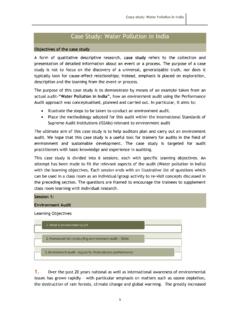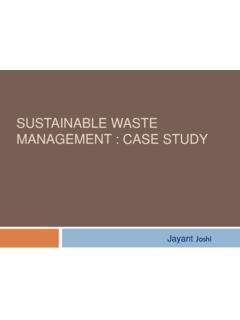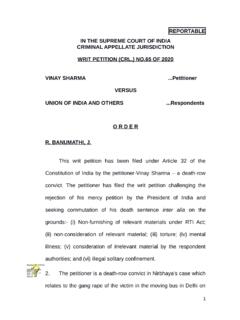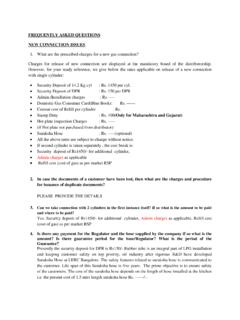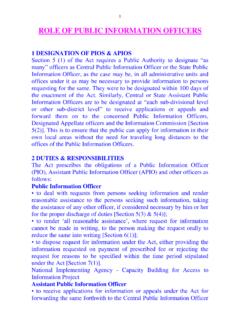Transcription of Environmental Impact Assessment (EIA): Overview
1 Environmental Impact Assessment (EIA): OverviewDr. Sanjay MathurHead, Center for Energy & EnvironmentCivil Engineering DepartmentMalaviya National Institute of Technology JaipurAgenda Defining EIA EIA & its evolution EIA principles EIA process Benefits of EIA3In EIA, the term impacts is used instead of effects of activities. What is an Impact ?Definition of EIAE nvironmental Impact Assessment isA formal process for identifying: likely effects of activities or projects on the ENVIRONMENT, and on human health and welfare. means and measures to mitigate & monitor these impacts Environment is broadly interpreted: Physical: Water, Air, : flora, fauna, ecosystemSocial: human health and welfare, culture, religion, and local values4 What is an Impact ?The Impact of an activity is a deviation (a change) from the baseline situationthat is caused by the measure an Impact , you must know what the baseline situation is.
2 !The baseline situationis the existing Environmental situation or condition in the absence of the baseline situation is a key concept in baseline situationIn characterizing the baseline situation, many Environmental componentsMAY be of interestWaterQuantity, quality, reliability, accessibilitySoilsErosion, crop productivity, fallow periods, salinity, nutrient concentrationsFloraComposition and density of natural vegetation, productivity, key speciesFaunaPopulations, habitatSpecialKey speciesecosystemsEnv HealthDisease vectors, pathogensThe components of interest are those that are likely to be affected by your activity or upon which your activity depends for its successDefining Impact AssessmentEnvironmental Impact Assessment is, in its simplest form, a planning tool that is now generally regarded as an integral component of sound decision.
3 As a planning tool it has both an information gatheringand decision makingcomponent which provides the decision maker with an objective basis for granting or denying approval for a proposed development. Justice La Forest, (1991)Defining Impact AssessmentEnvironmental Impact Assessment (EIA) may be defined as a formal process used to predict the Environmental consequences of any development project. EIA thus ensures that the potential problems are foreseenand addressed at an early stage in the projects planning and design. Manu and Anshu Early 1970s -initial development 1970s to 1980s -trend to integration Mid to late 1980s -cumulative effects and policy integration Mid 1990s -towards sustainability (SEA-strategic Environmental Assessment , biodiversity) Evolution of EIAWHY DO WE NEED EIA? EIA is essentially a planning tool for preventing Environmental problems due to an action.
4 It seeks to avoid costly mistake in project implementation, either because of Environmental damagesthat are likely to arise during project implementation or because of modifications that are required subsequently in order to make the action environmentally acceptable to government and community. EIAs have two roles -legal and educational. The legal one is quite straight forward: to ensure that development projects has a minimal Impact on the environment in its entire 'lifecycle . The educational one is equally important and probably a forerunner to the legal role -to educate everyone one involved -professionals and users includedThink! a large section of society possibly see EIA processes as a 'hindrance' to development as environment is not yet a priority! We need to look at all our daily actions as eventually and cumulatively affecting the environment.
5 This includes our daily choices, where a delicate balance between financial and Environmental considerations need to be made automatically -without thinking!Purposes of EIA modify and improve design ensure efficient resource use enhance social aspects identify measures for monitoring & managing impacts informed decision-making provide justification for a proposal Integration within EIAThe EIA process addresses the following Environmental effects: biophysical & resource use social & cultural health & safety economic EIA guiding principles The EIA process should be: purposive meeting its aims and objectives focused concentrating on effects that matter adaptive responding to issues and realities participative fully involving the public transparent clear and easily understood rigorous employing best practicable methodology credible carried out with objectivity and professionalism efficient imposing least cost burden on proponentsSource: Sadler, 1996.
6 IAIA/IEMA 1999 ScreeningScopingAssessingDecision MakingReportingMitigationMonitoringPubli c InvolvementThe EIA ProcessClassification of EIA Activities Identification Identification of Environmental components and effects; presence or absence Prediction Forecasting change in the environment; estimation of probability of occurrence Evaluation Evaluation of importance, consequence and significance; also comparison of trade-offs among various alternativesWhen should the EIA be undertaken?Site Selection, Environmental Screening, ScopingDetail Assessment of impacts, Identification of mitigation needs, Input to cost benefit analysisDetail design of mitigation measuresImplementation of mitigation measuresPre FeasibilityProject ConceptDesign and EngineeringFeasibility StudyImplementationMonitoring and EvaluationLessons for future projectsWho is involved in the EIA process?
7 EIA is generally the responsibility of the project proponent It is often prepared with the help of external consultants or institutions, , the EIA practitioners. The EIA study should be carried out by a multidisciplinary team comprising civil engineers, water supply and sanitation engineers, planners, chemists, life scientists, and socio-economists. The agency responsible for receiving the Impact Assessment report and taking any subsequent action. will usually indicate how the study is to be carried out and how the results should be used in the decision-making process. Apart from all these agencies, the general public is also involved in the process of EIA. Ideally public opinion should be solicited through public hearings arranged for the purpose of discussing the impacts of the project. Public participation as a component of EIA is practiced as a requirement in only a few countries, including INDIA.
8 EIA Costs for Multipurpose ProjectsDelays are caused during EIA when: EIA is commenced too late in the project cycle TORs are poorly drafted EIA is not managed to a schedule EIA report is inadequate and needs to be upgraded Lack of technical data Benefits of EIA include: more environmentally sustainable design better compliance with standards savings in capital and operating costs reduced time and costs for approvals avoids later plant adaptations reduced health costs increased project acceptanceThanks To ensure that opportunities of future generations are not limited, we must all use our valuable natural resources more efficiently. This can be best achieved through combining best technology as well as management Impact Assessment in INDIADr. Sanjay MathurHead, Center for Energy & EnvironmentCivil Engineering DepartmentMalaviya National Institute of Technology JaipurAgenda EIA process in India SWOT analysisEIA Notification 2006 Published in the Gazette of India, under sub-rule (3) of Rule 5 of the Environment (Protection) Rules, 1986, on 14 September candidates for EC All new projects or activities listed in the Scheduleto EIA notification 2006 Projects or activities which cross the threshold limits given in the Schedule, after expansion or modernization.
9 Any change in product -mix in an existing manufacturing unit included in Schedule beyond the specified Authority Ministry of Environment and Forests for matters falling under Category A in the Schedule State Environment Impact Assessment Authority (SEIAA) for matters falling under Category B in the ScheduleCompetent Authority All projects and activities are broadly categorized in Category A and Category B, based on the spatial extent of potential impactsand potential impacts on human health and natural and man made resources. The EACs at the Central Government and SEACs at the State or the Union territory level shall screen, scope and appraise projects or activities in Category A and Category B respectively. Stages in the EC Process Stage (1) Screening (Only for Category B projects/ activities) Stage (2) Scoping Stage (3) Public Consultation Stage (4) AppraisalStage (1) Screening Category B projects/ activities Screening for further level of EIA Category B1/ B2 EIA is required for all projects in category B1 except Item 8 of theSchedule (Construction/Township/Commercial Complexes /Housing) Stage (2) Scoping Scoping.
10 Refers to the process by which EAC/ SEAC determine detailed and comprehensive Terms of Reference addressing all relevant Environmental concerns for the preparation of an EIA Report Decision making shall be on the basis of the information furnished in the prescribed application Form1/Form 1A including ToRproposed by the (2) Scoping All projects/ activitieslistedas Category B in Item 8 ofthe Schedule shall not require Scoping and will be appraised on the basis of Form 1/ Form 1A and the conceptual plan. Applications for EC may be rejected by the EAC/ SEAC at this stage itself. Such decision together with reasons for the same shall be communicated to the applicant in sixty (3) Public Consultation The process by which the concerns of local affected persons and others who have plausible stake in the Environmental impacts of the project or activity are ascertained All Category A and Category B1 projects/ activities shall undertake Public Consultation.
